Safety First: Evans Roofing Co. is the First to Achieve VPP
Evans Roofing Co. Embraces Safety as a Core Principle and is Setting the Industry Standard
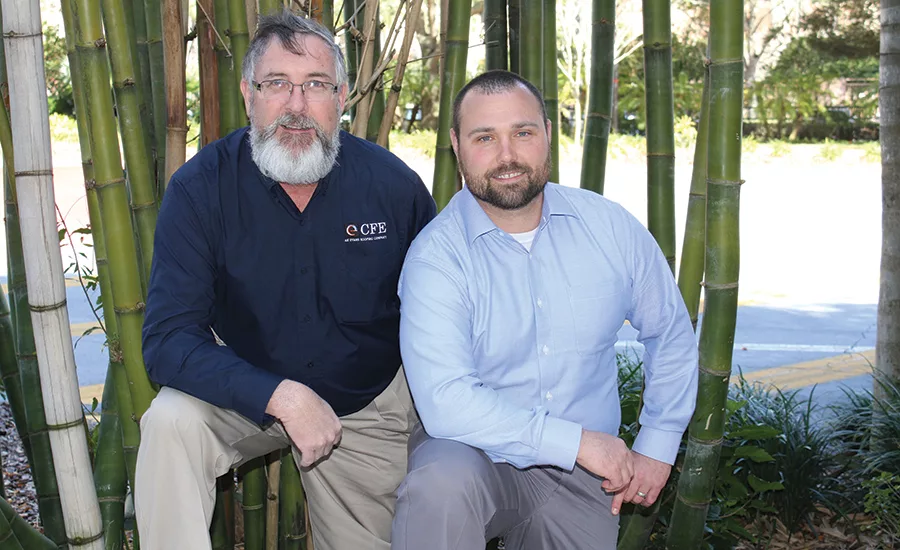
Aaron Whaley (left) and Dan Nowak are two of the leading voices on worker safety at Evans Roofing Co. that helped it achieve OSHA VPP Star status. Photo by Karen McConnell.
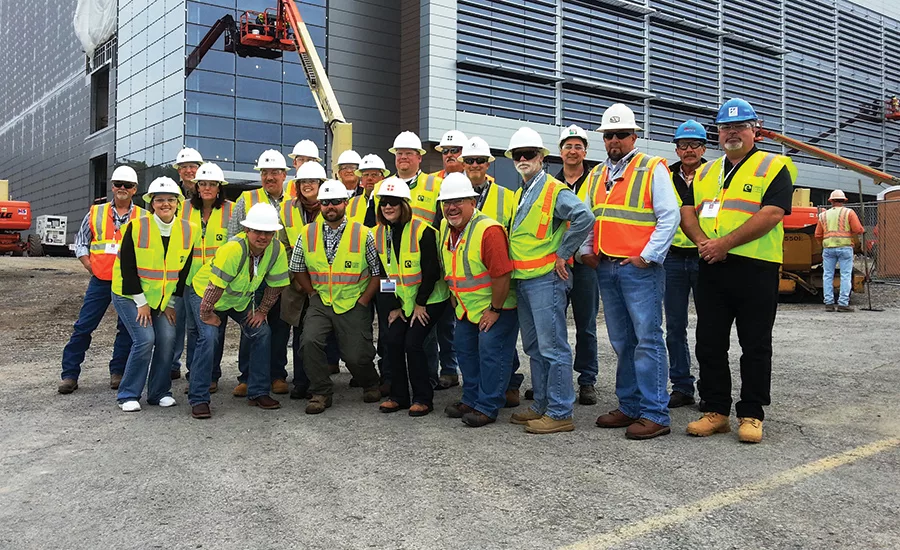
Photos courtesy of Evans Roofing.
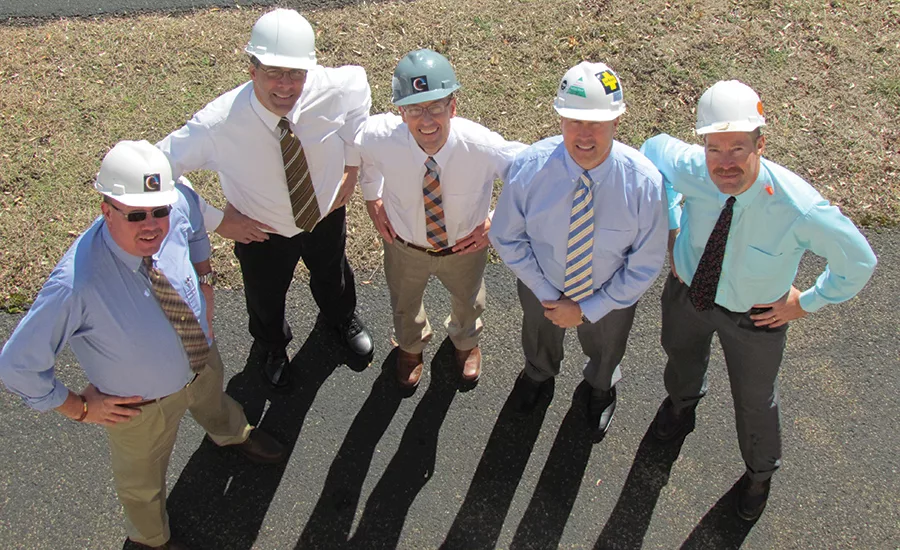
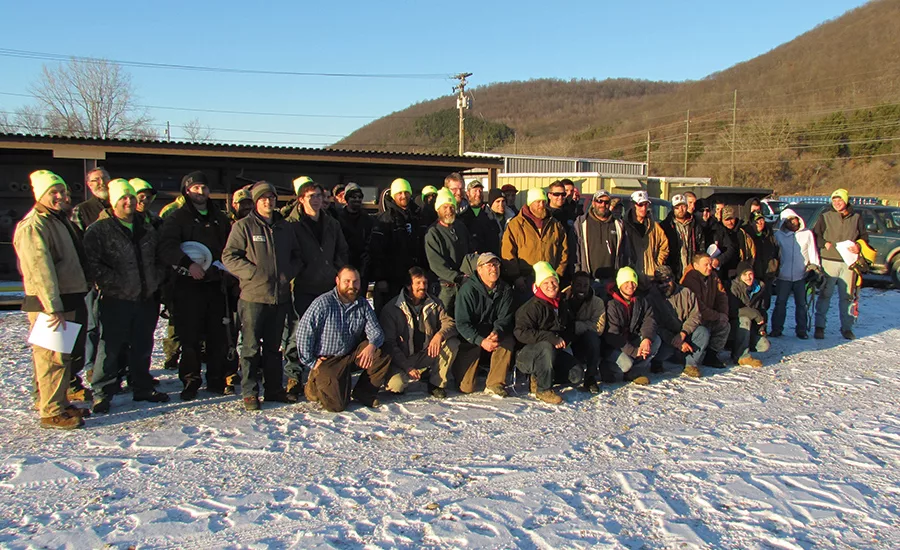
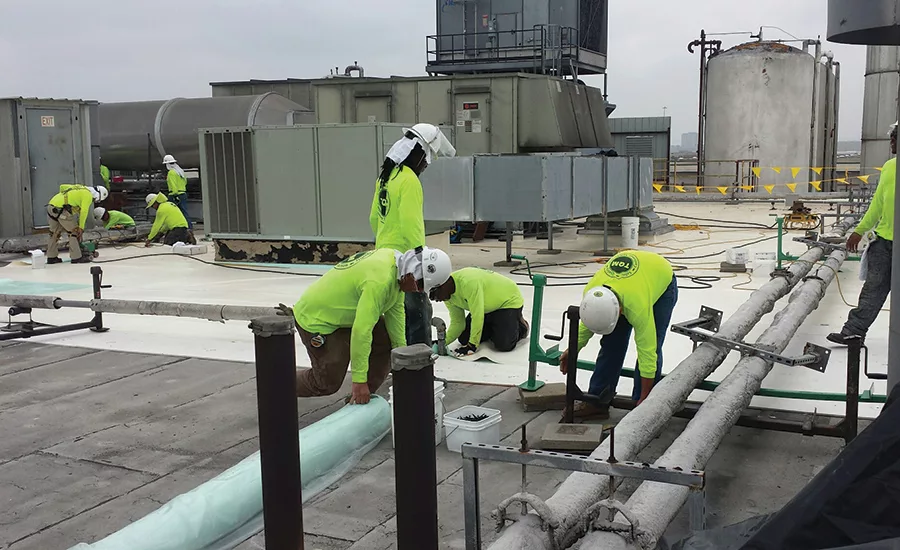
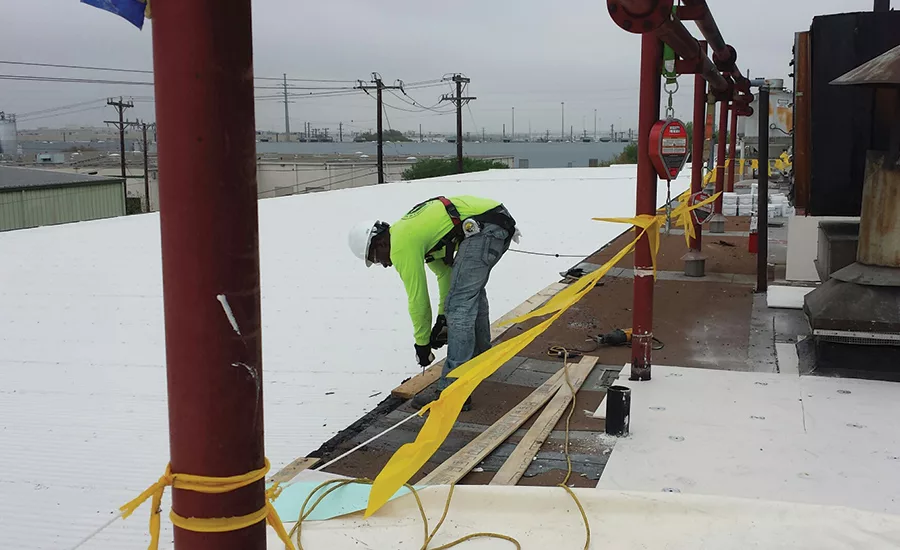
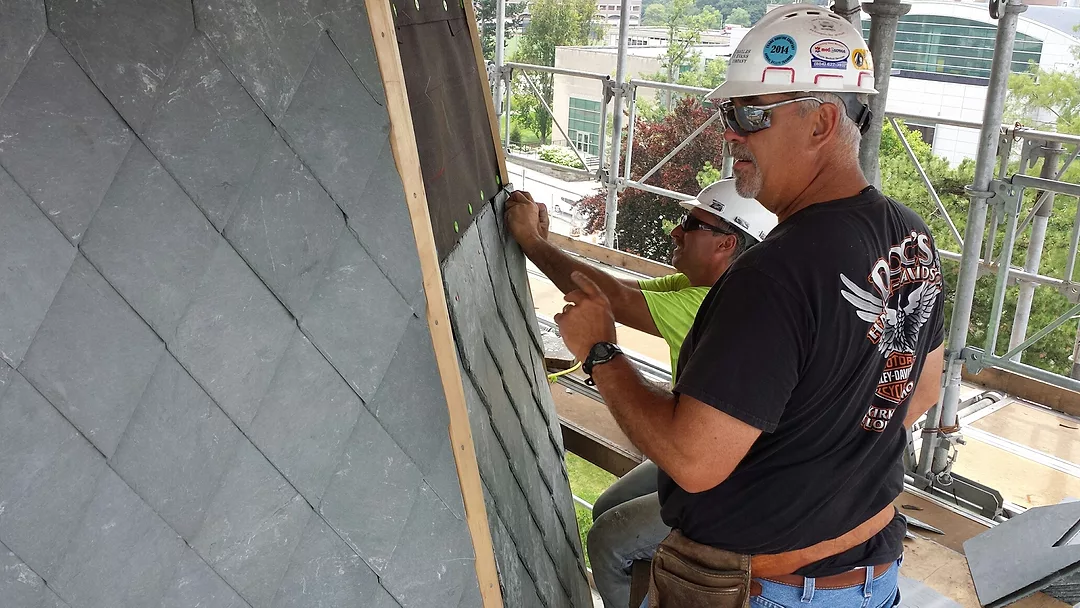
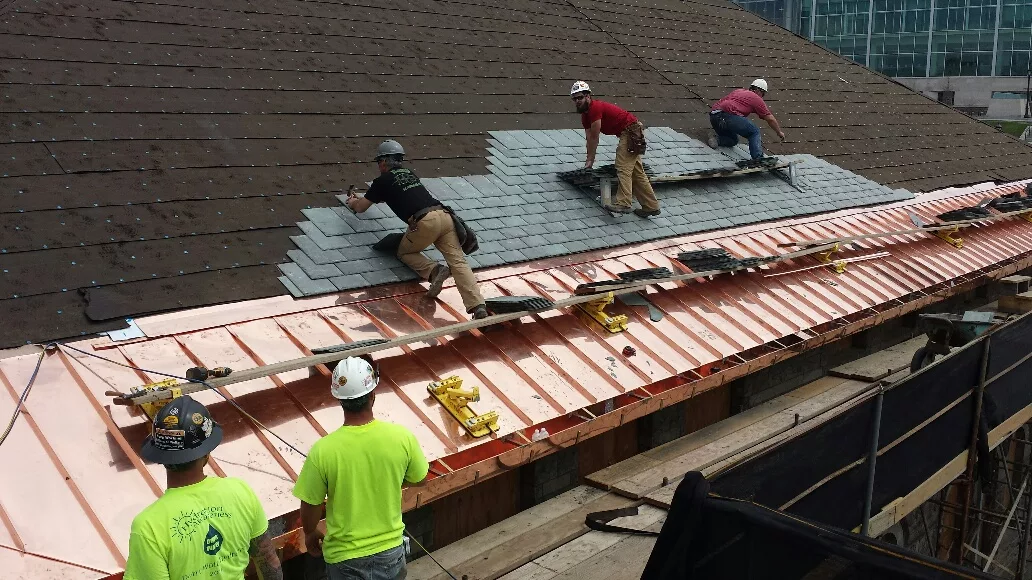
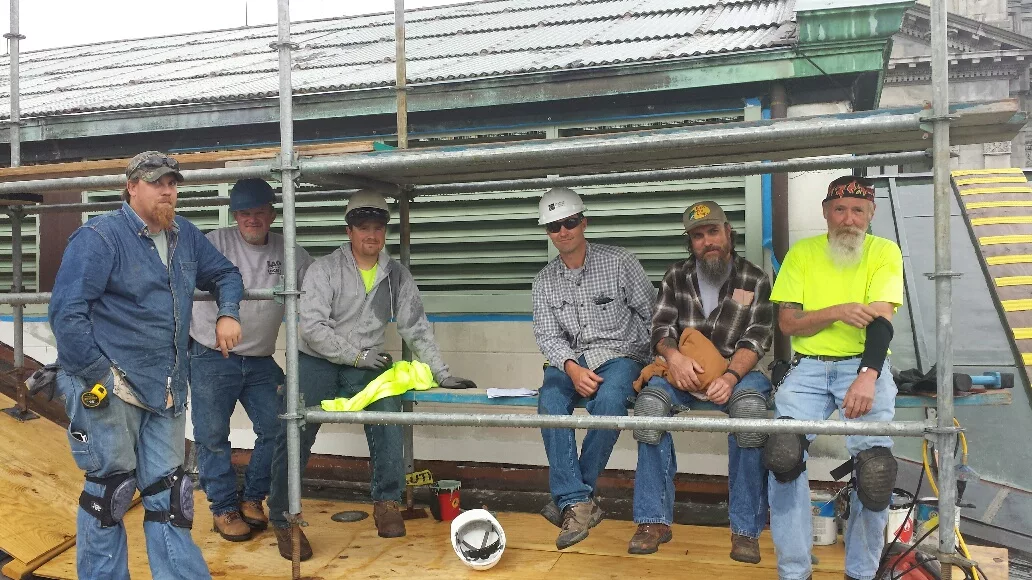
By most accounts, roofing contractors have one of the most dangerous jobs in the United States — generally ranked within the top five or six on any most-dangerous job list. To put it into perspective, that’s typically ahead of fighting fires or fighting the enemy as an enlisted soldier.
To stay in business, roofing contractors need to keep the qualified, skilled workers they do have safe, and almost all talk a good game when it comes it making safety a priority. However, few embrace it as strongly as an organization like the employees at Evans Roofing Co., where from top to bottom, the mission is clear: adhering to safety protocols that exceed the industry standard is a way of life.
Building the Foundation
Evans is based in Elmira, N.Y. and has divisions located in Virginia and North Carolina. It’s comprised of two subsidiary companies that serve both union and non-union markets. The Charles F. Evans Company, Inc. has about 50 employees that handle all union-bid work; and CFE Inc. was founded in 1983 to complete non-union jobs in their respective regions. It currently has about 200 non-union employees. Both companies offer re-roof, maintenance and repair services to a base of commercial clients across the country, as they are licensed to operate in more than 40 states.
The companies together put the Evans Roofing umbrella’s national footprint at more than 120 million square feet. Equally impressive are annual sales hovering at about $28 million, and a single-job bonding capacity of $40 million.
That success is probably a bit beyond what Charles F. Evans intended when he started the company in 1945. He immediately began working exclusively with commercial properties and never wavered from a commitment to professionalism and quality, regardless of economic cycles, said former Evans part-owner Kevin Kennedy.
Kennedy, a long-standing member of RC’s Editorial Advisory Board, and author of RC’s Exit Planning column, joined Evans in 1980 and helped transition the company to its-fourth generation of owners in the late 1990s. During his tenure, Evans implemented a Total Quality Management (TQM) system that drove management’s approach to long-term success via customer satisfaction. To do that, the company developed three core pillars and required full engagement from every employee to revamp their business culture. Safety, quality and customer satisfaction became the company’s chief priorities, and as the employees improved in those areas, revenue growth seemed to follow.
Businesses that fully embrace the TQM process must develop a strategic and systematic philosophy that fosters continued improvement and accountability. When it came to safety, company officials didn’t hesitate to become an industry leader.
Achieving VPP
The Occupational Safety and Health Administration (OSHA) acknowledges businesses that strive for improving safety within their companies. In 1982, it established the Voluntary Protection Program (VPP) to give official recognition to those employers that take significant steps to continuously improve safety procedures and exceed industry standards.
The agency developed rigorous criteria for participation that includes an application process, numerous onsite evaluations by OSHA inspectors and health experts, and continued self reporting.
To apply, companies inside and outside of the roofing industry must have effective safety and health management systems that consistently rank below the national averages for death, injury and illness rates in their respective lines of work. During this process, company management and employees work as a team directly with federal regulators to minimize safety incidents through increased hazard control, ongoing worksite analysis and commitment to training.
OSHA classifies VPP candidates through three programs that can take years to complete: demonstration, merit and star.
Demonstration status is reserved for individual programs designed to meet a specific set of criteria approved by OSHA one at a time. Merit status is awarded to companies that achieved full VPP status, but have additional steps to take to reach the star level. Star status can typically take another year to 18 months to achieve and involves expected enhancements in employee engagement, and specific program testing related to the use of safety products and certain building materials in the application of roofing systems.
Evans started the process in 2007 and achieved Merit status for a mobile workforce within 16 months. Both Evans and CFE achieved VPP Star status in 2012, and remain the only roofing contractors in the U.S. to hold the distinctive honor.
The process was arduous and maintaining the status to this day requires a high level of focus from the company’s dedicated environmental health and safety department (EHS) staff.
“It’s not easy, it takes time and it takes revenue, but once you get there, you can’t do anything better for your people,” said Vice President Bob Pringle. “You’re not compromising safety and their ability to go home at the end of the day for time and profit.”
Pringle joined Evans in 1992 and became its first full-time safety manager. With a vast background in construction and a great deal of experience in industrial safety, he was granted wide latitude to develop a safety and health program for a company looking to grow an already large client list spread across the country with disparate safety procedures and expectations. Without a model to follow within the roofing industry, one of his first acts was enrolling Evans as an associate member of the VPP’s participant association. From there, the dream of growing into a national industry leader in safety became a series of pro-active steps — albeit labor-intensive — that appeared more and more attainable the deeper Evans got into the process. OSHA officials were no longer feared or shunned on jobsites, and became true partners in helping the company evolve.
In return for the cooperative partnership, Evans and other VPP participants are removed from OHSA’s programmed inspection list. They’re still subject to certain inspections and must comply with all regulations, but achieving VPP status means participants conduct reviews on their own and report their results to the agency.
That was an expected benefit for a company with jobsites across the country. What was a bit unexpected was the impact emphasizing safety had on productivity, morale and profitability.
Under the TQM model, employees became actively involved in enhancing the safety program. Ideas for improvements are formally submitted and reviewed by a quality-improvement team, which then implements the ideas that have merit.
“Many of those ideas are now part of the everyday routine and even best practices on the roof,” said Dan Nowak, a corporate risk specialist in Evan’s EHS department. That was among the chief takeaways Nowak emphasized during his well-attended presentation of Evans’ VPP journey at the 2016 International Roofing Expo (IRE) in Orlando.
Going through the VPP process created an environment where no one’s role is marginalized and everyone is treated like family.
“Most national roofing contractors lose their identity and their responsibility to their employees, leaving a less desired environment to work in,” Pringle said. “We continue (Evans’) legacy in providing a safe and caring work environment with room for growth, advancement and ownership.”
The company’s also managed to turn safety into a profit center. It not only differentiates the company from competitors to win jobs in many different markets, but also reduces the company’s worker’s compensation liability and insurance costs.
“We don’t necessarily bring money in strictly from a safety standpoint, but we keep it from going out, which can be just as valuable,” Pringle said.
The VPP process is entirely voluntary, and a VPP firm may drop from the program at any time without penalty or negative consequence from OSHA. Participants are, however, expected to help other firms along the way toward VPP status and to continuously improve their own safety and health programs.
Pringle said that sharing Evans’ success story and actively discussing it via presentations at IRE or with trade associations is part of that process. Unfortunately, he said he’s heard only from companies outside of roofing with serious questions about achieving VPP status and requests for mentoring opportunities.
Pringle said he’s been in the construction business long enough to know that some contractors have a problem — or a perceived problem — of working closely with OSHA regulators.
“I just don’t believe it’s really caught on yet and that roofing contractors can see the benefit of what the process does for your organization,” Pringle explained. “People can have their ideas about OSHA, but we have an open line of communication with them. We involve them in anything we do that incorporates using new systems or techniques and it’s worked well. It doesn’t have to be an adversarial relationship.”
Safety Week
Pringle and other officials with Evans said they’re reminded of the benefits during a special week of training for all company employees that generally takes place at the beginning of the year. The effort, also known internally as safety boot camp, demonstrates the complete buy-in from the staff, including managers, supervisors, union and non-union employees alike, who work together daily to ensure employees are safe on every jobsite.
But it’s merely a continuation of the company’s emphasis on safety that starts before a job candidate is even hired. Each potential new hire is required to pass a mandatory drug screening, and those that do begin with a two-day safety orientation. New employees that complete the orientation are then placed in a mentoring program and paired with a more experienced crew member for two full months.
Regardless of age or experience gained from work at prior companies, each new employee is required to participate in all facets of the Evans training program.
“We may have people come to us with a lot of experience and prior training on safety procedures that they learned somewhere else, but the response is always the same,” Nowak said. “We tell them, that’s nice, but we stress to them the importance of our training, of what they’re supposed to do on the roof, what they’re supposed to do on the ground and what they’re supposed to do in our facility before they even get to a jobsite. That way, they know what we expect from them to work with us.”
Beyond that initial mentorship phase, Evans requires employees to complete educational and training sessions twice a year. That comprehensive training includes:
- OSHA 30 hr., aerial lift training
- Shop forklift and rough terrain forklift training
- Fall protection
- Fire extinguisher use and fire protection
- Defensive driving
- First Aid/CPR
- Leadership
- TQM principles
Subcontractors are also required to participate in the safety program.
“Every associate within our organization understands that their health and well-being is first and foremost on any and all projects,” Pringle said. “As a TQM company, associates are rewarded and recognized for their team work and dedication towards our goal of zero incidents on all projects.”
The TQM model also allows for clients to be involved in enhancing the company’s policies and procedures.
“Feedback from our customers is very important and critical for our continued success,” Pringle explained. “About 72 percent of our business is repeat business, so it says a lot of our craftsmanship, quality and safety.
“We truly feel safety is a partnership between contractor and owner,” he continued. “When that goes well, we establish a good relationship with the customer or general contractor, which in turn provides us with more work opportunities.”
To ensure quality, Evans managers conduct a series of field-quality audits throughout the job cycle and teach hands-on detail sessions in the classroom based on those audit results. The sessions are developed from manufacturers and are often required in conjunction with installation warranties.
“It’s our quality recipe for ensuring manufactured warranties for our client installations,” Pringle said.
Some of the innovations and best practices that Evans developed over the years include; all safety and health information on electronic tablets; fall protection equipment inspection tags (QR-coded) for accountability; project specific fall/rescue plans; equipment inspection checklists on weather-resistant punch cards; the new-hire mentoring program and a ladder repair program from an outside vendor.
In addition to OSHA, organizations outside of the roofing industry recently began to notice Evans’ proficiency in workplace safety.
CFE, Inc.’s North Carolina division was the first roofing contractor to receive the North Carolina Building Star. The award recognizes companies with worksites that are self-sufficient in controlling hazards and meet all statewide safety standards. The division has maintained the prestigious award since 2007.
Last year, Evans was among four finalists to present at the Western New York State Safety Conference in Niagara Falls and won the first annual safety innovation of the year award for its VPP efforts.
Still Evolving
Even with so much emphasis placed on safety, the crews at Evans aren’t staying away from innovation and stay flexible enough to meet the demands of a changing marketplace. Evans now installs wall panels and other products that cover the entire building envelope, including air barriers and waterproofing. The company also offers other alternative-energy solutions, including solar roofing systems and green roofs.
Among the company’s recent projects is the Becton Dickinson Pharmaceutical Campus Center in Franklin Lakes, N.J. The complex structure had one floor above ground and two below, and Evans waterproofed and installed a LEED-certified vegetative roof.
Taking on historic or challenging projects is nothing new for Evans either. Last year, the company completed a two-year endeavor to re-roof and renovate the Goldwin Smith Hall at Cornell University in Ithaca, N.Y. The three-story structure was first built in 1893, and crews replaced more than 58,000 square feet of roof with Vermont Structural Slate and Revere Copper.
Staying versatile enough to meet such a broad range of roofing needs is part of any recipe for sustainable growth, Pringle said. Adding panels to the business model was a strategic exercise in expanding into new, non-traditional markets.
“I think to continue being a leader in the industry we have to look for new directions and capitalize on new opportunities,” he said. “Offering the customer a full building envelope proposal taking on a single source responsibility is a concept our existing customers were excited to hear.”
The recipe for success that keeps customers coming back is pretty clear: meeting and exceeding expectations; completing error-free work; valuing the cost of quality, and never, ever underestimating the importance of sending workers home safely today, so that they can return to work tomorrow.
“The biggest challenges to a national roofing contractor are to ensure the owner uses a pre-qualification process for their bidding contractors. Good competition is key to overall price, however, ensuring your bidding contractors have strong safety and quality programs within their organizations is critical.”
Looking for a reprint of this article?
From high-res PDFs to custom plaques, order your copy today!







